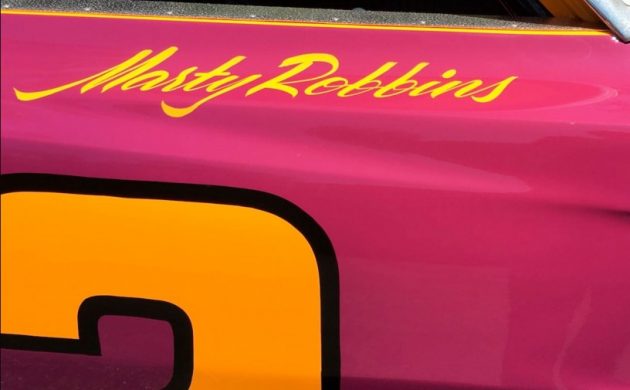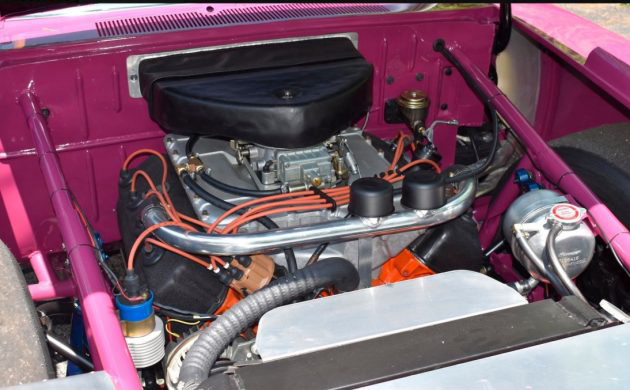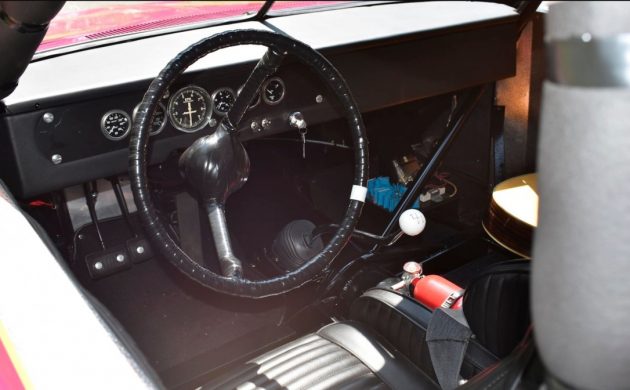Depending on the category that you choose, motor racing can be very affordable, or it can be ruinously expensive. If you desire to compete at the upper echelon, you either have to have the talent to score yourself a drive, or you need the funds to do things your own way. That is why there have been many celebrities over the years who have taken some of the money that they’ve earned plying their trade on the screen or in the recording studio, and poured it into going fast on four wheels. One of the more notable examples was country music legend Marty Robbins. His enormous recording success brought with it financial security, and the opportunity to fund his own entry into NASCAR competition. One of his more desirable race cars has been unearthed and restored, and it is set to go to a new home. It is this 1969 Dodge Charger Daytona, which is located in Orlando Florida. It is listed for sale here at Mecum Auctions, and it is set to go under the hammer from July 29th to 31st. I have to say a huge thank you to Barn Finder Larry D for spotting this amazing car for us.
This Dodge didn’t start its competition life as a Daytona. It originally hit the track in late 1967 as a 1968 Charger in the hands of James Hylton. It remained in his hands as a Charger 500 until 1969, when it was purchased by Robbins. He enlisted the help of Bobby and Eddie Allison to convert it from Charger 500 specs to a full-blown Daytona. The car made a single start in Robbins’ hands at the 1970 National 500 at Charlotte Motor Speedway as a Daytona before it was again sold. The car was re-bodied as a regular Charger 500 due to the aero rule changes, and after being damaged in a competition accident and fire in late 1973, it disappeared. It was discovered in 2005, and various people involved in the development and build were able to confirm the authenticity of the vehicle. It had deteriorated after more than three decades in hiding, and a complete restoration was undertaken. I guess that if you are going to task someone with the restoration of a historically significant NASCAR, handing it to the legendary Ray Evernham’s Big Iron Garage in Mooresville, North Carolina, would be a smart first move. The car was painstakingly returned to the state that it was in during its single race with Robbins at the wheel, and the result is stunning. It wears his characteristic shades of Magenta and Chartreuse and carries the original racing #42. Overall, the presentation is extremely impressive, and it seems to need nothing. I have checked many period photos, and it seems that all of the correct decals and stickers are present. Restoring the vehicle wasn’t as straightforward as you might think, because ongoing evolution meant that sourcing some parts was a challenge. Chief among these were the wheels. When Robbins drove this car, it rolled on a set of Nichels NASCAR wheels. These are no longer in production, but Evernham’s managed to locate and restore a set in the correct shade of yellow. Overall, the car now makes a stunning display piece, but as you will see, that display doesn’t necessarily need to be static.
The Dodge Charger Daytona might have looked wild on the outside, but the engine bay was no less exciting. What we find here is the iconic 426ci Hemi V8 that would have pumped out an official 425hp in roadgoing form. Of course, plenty of items were changed in the pursuit of more speed, and even in 1970, the power output for one of these V8s in racing trim was generally believed to be well north of 600hp. This engine was built by Ray Barton Racing Engines and features a host of period-correct racing components. Bolted to the back of the Hemi is an A833 manual transmission that feeds all of those horses to a reinforced 8¾” rear end. This Daytona isn’t merely about good looks, because it does run and drive. It has performed a few on-track displays, including turning a few laps at Talladega. When Robbins campaigned this car, he acquitted himself extremely well. At Charlotte, he qualified 33rd out of 42 starters. In the race, he was classified 32nd after suffering engine issues early. It wasn’t the result that he had hoped for, but it was nothing to be ashamed of, either.
While NASCAR’s from this period were derived from production road cars, their interiors were anything but stock. Anything that was deemed unnecessary was removed to save weight and improve safety, and all that the occupant was left with was a single bucket seat, a racing harness, a cluster of gauges, and enough tubular steel to construct a small bridge. The tubular roll cage serves two purposes. The first is to keep the occupant safe if things go wrong, while it is also used to tie all of the suspension mounting points together to provide high levels of torsional rigidity. Today, the size and placement of these bars is strictly controlled, but that wasn’t the case in 1970. That is what made confirming the identity of this car pretty easy. It was originally built and raced by James Hylton. His car featured some distinctive bar-work, and it was this that solved the mystery. The Daytona has been restored to how it looked at Charlotte in 1970, with all of the correct gauges, along with the right seat and wheel. The car has been used for moving displays, and the original fuel cell has made way for a modern unit to comply with today’s safety regulations. Otherwise, it is all as it would have been 51-years-ago.
It is easy to dismiss moneyed celebrities that pull on the helmet because sometimes their ambitions far outweigh their abilities. Marty Robbins was realistic about his abilities and knew that he was never going to challenge for a championship. However, his sporadic outings netted him six Top-10 finishes. He also twice qualified for the iconic Daytona 500, which you don’t do if you lack talent. With those thoughts in mind, it makes you wonder how successful he might have been had he managed to compete in more than thirty-five races over 16-years. We will never know the answer, but this could be your chance to follow in his footsteps by slipping behind the wheel of this 1969 Daytona. I can think of worse ways to occupy my time, can’t you?






Drivin’ a race car is my way of makin’ a livin’
My way of puttin’ the bread on the table at home
I’m gettin’ back about half as much as I’m givin’
And I couldn’t make it without a good woman at home
First Place could be just a dream, but I’m gonna chase it
Finishin’ out of the “Top Ten” is nothin’ but bad
In a “junker”, won’t ever be first, I might as well face it
First Class equipment is somethiing a man’s got to have
You might even call me a twentieth century drifter
Thirty-two week-ends, I load up the car and I’m gone
And my woman cries with each “good-bye” kiss that I give her
And she prays that come Monday mornin’, I’ll be driftin’ home
Well, my woman sleeps in my arms and I lie here thinkin’
Half awake, half asleep, I run and re-run the race
From Dark until dawn, it goes on, my half-awake dreamin’
And every so often, I dream that I’m takin’ First Place
But it’s got to be more than a dream – dreamin’ won’t make it
Aw, dreamin’ won’t ever put bread on the table at home
And racin’ runs deep in my veins. I’ll never shake it
I’m tied to it just like I’m tied to that woman at home
You might even call me a twentieth century drifter
Thirty-two week-ends, I load up the car and I’m gone
And my woman cries with each “good-bye” kiss that I give her
And she prays that come Monday mornin’, I’ll be driftin’ home
https://m.youtube.com/watch?v=5STKsn5yJCk
Aww, what’d you go and do that for, Bluetec320? Dang it, now I’ve got that in my head for the rest of the day!!😆
He put on a helluva performance at the 1973 Firecracker 400 and Talledega-it’d be great to watch this car do a lap on the track one more time.
In a historical note, at the ‘74 Charlotte 500 Robbins deliberately crashed into the wall to avoid a T-bone with Richard Childress who had come to a stop sideways on the track, and is credited with possibly saving Childress’ life because of his reaction.
Wonder if that attitude would still prevail today?
This is also a great vid featuring Jerry Reed and Marty Robbins.
https://www.youtube.com/watch?v=3ZtUnD2r3xg
I wonder where it was found?
Excellent write-up Adam. Full of detailed historical information. Looks like a great restoration, but it seems a very limited audience would want to own it.
This car will appeal to multiple niches, winged car/mopar enthusiasts, Marti Robbins fans, country music fans but probably the ones most willing to spend money are guys that run nostalgia races. The most prestigious races only allow cars with a documented history in a specific class to participate. The participants in those events often have specialty shops perform restorations and maintain the cars between events, arrange transport and supply crews at races. If this car fits into a category that is popular, that is probably what will drive the price.
Steve R
When NASCAR started racing trucks, I e-mailed them and suggested a classic or nostalgic racing series. Vintage cars with modern safety equipment, and readily available crate engines.
Obviously, they aren’t interested in having Talladegas and Superbirds duking it out. With their declining ratings and general lack of interest by the kids of today’s fans the sport is pretty close to returning to its roots.
All that’s left is for enthusiasts to start their own racing league and reopen tracks like North Wilkesboro and Rockingham.
Real racers don’t need TV coverage.
They are not NASCARS. They are NASCAR race cars.
There are very few classic stock cars I would want in my garage, but the two I would take IN ANY condition would be ones driven by Bobby Isaac and Marty Robbins. Okay, MAYBE that Petty kid’s blue Plymouth.
Thanks for this! I knew a little about Marty Robbins now I’m going learn somemore, as for the history of the car you could talk hours just about all the famous people that restored it, these seemed to be hard times not really understanding they were the best of times I hope it takes first place money at the auction.
I’m trying not to nitpick, but if you want to see what color Chartreuse is – look up a paint chip for a 1950 Ford Crestliner (the original color nearly burned a hole in your eyes at first glance…).
Interesting about the 8.75 inch rear end. Didn’t hemi street cars all get Danas? Maybe less rolling resistance on the smaller rear?
The original Hemi street cars did get a Dana rear. The racers typically used the 8 3/4″ since it was lighter and easier to swap chunks for different tracks. They would have an assortment of gear ratios on hand. Interestingly they also used an open rear, sure-grip was not helpful. This car also has the floating axles which makes it also more easy to swap the chunk.
Funny that you should mention that. Back in the 1960s it seemed like every West Coast racer had a Halibrand quick change rear axle but they never caught on in NASCAR.
Never thought much of the the Daytonas but the restoration of this car is a good as I’ve ever seen. Keeping the race car history alive needs pieces like this.
Let’s see…crash…fire…abandoned for 30-odd years then who know how many more before work started…yeah, checks all the boxes. Is it still a restoration if you replace the head and the handle?
As you know, unlike street cars, these cars were re-skinned, repaired, over and over. Sometimes after each race. The key to these cars is the chassis. If the original chassis is complete, as was this one, then that in fact is the car.
Sounds like the kind of story Pixar would glom onto for its next Cars film.
Why don’t somebody start a sanctioning body that runs old school Racing as it should be,or are we too late to show the next generation how to Race What you got? Hell if the “Bad News Bears”can do it- and I’m not talking “Here Hold My Beer While I Weld This” Racing.